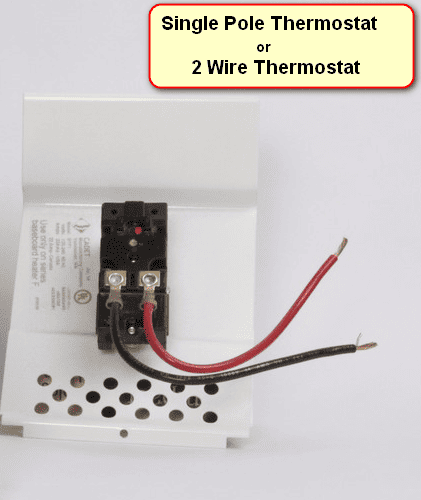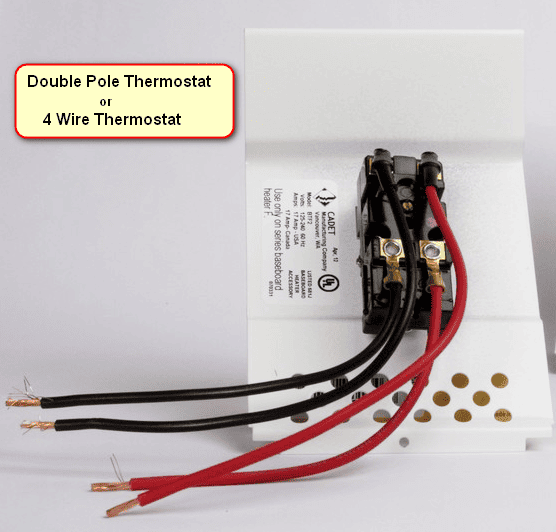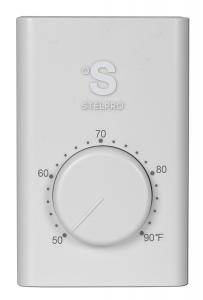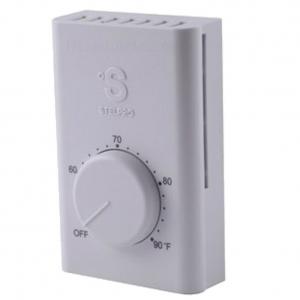If you are shopping for a thermostat for your baseboard heater (or for any line voltage based heating system), you may have heard the terms – Single Pole Thermostat and Double Pole Thermostat. If you are a bit confused looking for differences between the two, you are not alone! In this article, we help you understand the exact difference between a Single Pole Thermostat and Double Pole Thermostat.
The very basic difference between a Single pole and a Double pole thermostat is that a Single pole thermostat cannot be turned “OFF” completely. Hence a single pole thermostat never turns the electric heater OFF by cutting the power supply line from the heater. A double pole thermostat has an “OFF” setting and a double pole model can be turned “OFF” completely by isolating the electric heater from the power supply line. A double pole thermostat (when set in the OFF position) completely turns OFF the electric heater from the power supply line.
Take a look at the pictures given below: You can see the single-pole thermostat has no “OFF” position, while a double pole thermostat has an OFF position.
What happens in a Single Pole Thermostat?
We saw that a Single pole thermostat has no “OFF” setting in the device. You might be thinking what is the left-most position (the minimal setting) in a Single pole thermostat. Well, that’s actually a low setting (usually set at 45 degrees Fahrenheit). The heater will be turned “ON” when the temperature dips below the set point (45 degrees or whatever set value is minimal setting). So in the case of a single pole thermostat, the power line is always connected to the thermostat and to the baseboard heater.
Unlike a Single pole thermostat, the leftmost position in a Double pole thermostat (turn the knob all the way in counter-clockwise direction) is marked “OFF”. In this position, the thermostat and the heater will be isolated from the power line. The thermostat will not measure/sense the surrounding temperature as well when kept in the OFF position. So in this position, the heater will not turn “ON” even if the temperature dips below a certain value. The heater will be kept “OFF” until the thermostat is turned “ON” and set to a certain temperature value.
What’s the takeaway ?
We now know the difference between a single pole and double pole thermostat. So what’s the takeaway from what we have learned? Well, the most important one is that a single pole thermostat throws some safety concerns owing to the fact that the electric heater is always connected to the power line (even at the low setting).
Electric heaters are usually required only during the cold season. In most homes, electric heaters are not used during summer. Consider a scenario in which you have a single-pole thermostat controlling your heater. During summer you set the thermostat to its low point and go away on vacation. Since the heater is not in use, you might have placed many items carelessly near your heater (worst case: directly in front of your heater). Now, what if there is a sudden climate change and temperature dips unexpectedly? Your single pole thermostat will turn the heater “ON” when the temperature falls below its minimal setting. Since you are away, you don’t get a chance to move things kept near your heater. The potential fire risk is very high in such a scenario.
Note: All kinds of heaters have certain minimal clearance requirements. Read about baseboard heater safety tips in our guide.
It’s always safe to turn your electric heater OFF (completely isolated from the power line) when you are away. However if you don’t take long vacations (staying away from your home) and if you always keep a check on things placed near your heater, you can go with the single pole thermostat option.
Identifying a Single Pole Thermostat and Double Pole Thermostat
Now as you know the basic difference between a Single pole and a Double pole thermostat, let’s see how to identify between the two. The most simple method to identify between a Single pole & a Double pole thermostat is to look at the backside of the thermostat.

If you see two wires coming out of the back of your thermostat, you have a Single pole thermostat in your hand. And if you see four wires coming out of the back, you have a Double pole thermostat in hand. Easy & simple identification – right ?

Note 1: If you are checking a connected thermostat (thermostat connected to electric heater line), first turn OFF the main power line or turn OFF the power at the breaker that powers your electric heater. Now take off the thermostat from the wall (or the attachment) and inspect the backside.
Note 2: If you have more than four wires coming out of the back of your thermostat, you might have a low voltage thermostat in your hand. Please note low voltage thermostats can not be used to control electric heaters (baseboard heaters). Low voltage models are used to regulate other types of heating systems like a heat pump, boilers, gas furnaces etc.


